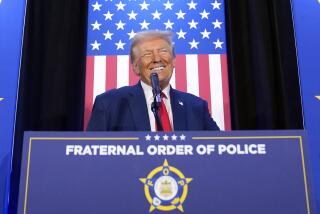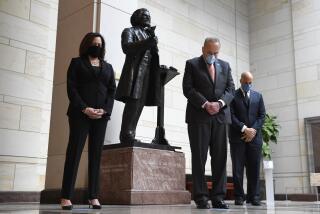Trump is ending restrictions that limit the military from giving surplus gear to police
Reporting from Washington â President Trump moved Monday to again allow the Pentagon to distribute surplus armored vehicles, grenade launchers and large-caliber weapons to local police, his latest reversal of an Obama-era policy intended to stop militarization of law enforcement.
Trump signed an executive order reversing the limits that President Obama had imposed after heavily armed police had used military equipment to quell street protests in Ferguson, Mo., in 2014.
Atty. Gen. Jeff Sessions, who has sought to restore tough-on-crime policies and remove what he sees as shackles on law enforcement, told a police union Monday that Obamaâs restrictions âwent too far.â
Trumpâs order, he told the group, âwill ensure that you can get the lifesaving gear that you need to do your job and send a strong message that we will not allow criminal activity, violence, and lawlessness to become the new normal.â
Under the program, created by Congress in 1990, the Pentagon has transferred $6.6 billion worth of military gear, including tracked vehicles and heavy weapons used by SWAT tactical teams, to local law enforcement agencies.
Trumpâs decision wonât change the Los Angeles Police Departmentâs approach to high-grade equipment from the military, said Deputy Chief Horace Frank, who oversees counter-terrorism and other special operations.
Though the LAPD gets helmets, ready-to-eat meals, tents and other surplus gear from the military, It has not obtained the equipment that prompted the Obama policy, Frank said.
âWeâve never been one to be going after grenade launchers. The tanks, the other entities â absolutely not,â he said. âOur goal is not to militarize the Police Department. Weâre not fighting the kind of war that the military is fighting.â
The LAPD has ballistic-plated trucks in its garages but they arenât military leftovers. In any case, Frank said, high-grade equipment alone wonât protect a city, Frank said.
âWe have to strike that balance between being tactically sound and tactically equipped and engaging the community,â he said.
The Pentagon program has come under sharp criticism for weak controls and poor oversight.
In July, a report by the Government Accountability Office said an investigator set up a phony federal law enforcement agency and, with fake identification, was able to pick up $1.2 million worth of equipment from Defense Logistics Agency warehouses â including night vision goggles and fake pipe bombs used in training.
The report called on the Defense Logistics Agency to improve its internal controls, saying it âlacked reasonable assurance that it has the ability to prevent, detect, and respond to potential fraud and minimize associated security risks.â
In response, the defense agency said it shut that part of its program for about a week to certify that equipment was going to legitimate entities. It said it is changing policies and adding training and internal controls âto ensure the program vulnerabilities are eliminated.â
Use of surplus military equipment by police made headlines three years ago when Ferguson erupted in violent protests after a white policeman shot and killed an unarmed black man, Michael Brown, in a scuffle.
Ferguson police responded to the protests with military weapons and armored vehicles â sparking a public outcry and criticism that the federal government had gone too far in helping to militarize local police departments.
Congressional committees held hearings but ultimately passed no new legislation to change the program.
In 2015, President Obama announced that he would end the military grants of surplus armored vehicles, grenade launchers and high-powered weaponry like .50-caliber rifles to local law enforcement.
âWeâve seen how militarized gear can sometimes give people a feeling that thereâs an occupying force, as opposed to a force thatâs part of the community thatâs protecting them and serving them,â he said. âIt can alienate and intimidate local residents and send the wrong message.â
As of November, the Defense Department had recalled 126 armored personnel carriers, 138 grenade launchers and more than 1,600 bayonets, which the department described as âeffectively heavy-duty knives with a single blade several inches long.â
The impact of Obamaâs order was largely symbolic since most of personnel carriers with tracks were outdated models from the Vietnam era, and few agencies had use for the grenade launchers, which were old models modified to shoot non-lethal devices like tear gas canisters.
The Defense Logistics Agency has continued to distribute other surplus equipment, including 875 MRAPs, the Mine-Resistant Ambush Protected trucks that were built to protect U.S. troops from roadside bombs during the Iraq war, and more than 400 other armored vehicles.
The program also still distributes military rifles and ammunition as well as body armor, helmets, shields and other protective gear to police.
âitâs pretty clear that in many places around the country local police departments went overboard in acquiring and using this type of equipment,â said David Alan Sklansky, a law professor at Stanford University who has studied policing issues. âOnce you have the stuff, it tends to be used.â
A lawyer with the American Civil Liberties Union said that, given the GAOâs findings, the Trump administration should be working to improve controls on the program instead of loosening them.
âItâs just hard to fathom that bringing weapons of war into our communities for policing enhances public safety,â said Kanya Bennett, an ACLU legislative counsel. âWeâve seen that it does not.â
Trumpâs decision to reverse Obamaâs order also drew criticism from some conservatives, who believe the Pentagon program smacks of a dangerous expansion of government power.
âIt is one thing for federal officials to work with local authorities to reduce or solve crime, but it is another for them to subsidize militarization,â said Sen. Rand Paul, (R-KY),who said he would push for legislation to prohibit the transfer of MRAPs, drones and other armored vehicles.
Some police groups have been working to overturn the Obama policy and enthusiastically welcomed the change.
âThe previous administration was more concerned about the image of law enforcement being too militarized than they were about our safety,â said Chuck Canterbury, national president of the FOP, in a statement.
During the presidential campaign, Trump promised to scrap Obamaâs restrictions, calling them âridiculousâ and praising the equipment grants as âan excellent program that enhances public safety.â
Under Sessions, the Justice Department has erased other Obama-era policies. Sessions ordered prosecutors to again file the highest possible charge in criminal cases, which could lead to longer mandatory sentences. He also has moved to negate limits on the ability of local police to seize cars, cash and other properties used in crimes.
In his remarks Monday, Sessions linked criticism of police â âportraying law enforcement officers as the enemyâ â to what he said were rising acts of violence against police.
âTheir divisive rhetoric treats police officers like the problem, instead of the crucial allies that you all are,â he said. âWe have your back.â
Tanfani reported from Washington and Kate Mather reported from Los Angeles.
Twitter: @jtanfani
ALSO
Under Obama, a gold mining firm was fine with a Mojave Desert monument. Under Trump, an aboutface
Trump travel to Texas now set for Tuesday, with promise to avoid hampering rescue efforts
ACLU sues Trump over transgender military ban
UPDATES:
1:10 p.m.: This article has been updated to include Atty. Gen. Jeff Sessionsâ speech and comments on the equipment policy in effect at the Los Angeles Police Department.
This article was originally published at 8:25 a.m.
More to Read
Get the L.A. Times Politics newsletter
Deeply reported insights into legislation, politics and policy from Sacramento, Washington and beyond. In your inbox three times per week.
You may occasionally receive promotional content from the Los Angeles Times.












